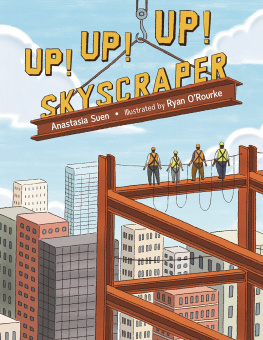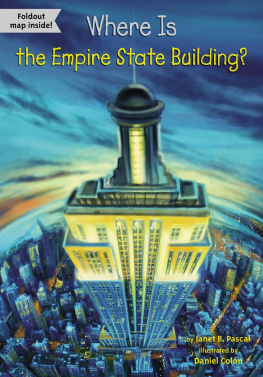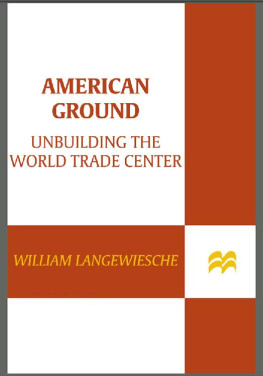To those of us
who don't always
appreciate things
until they are gone.
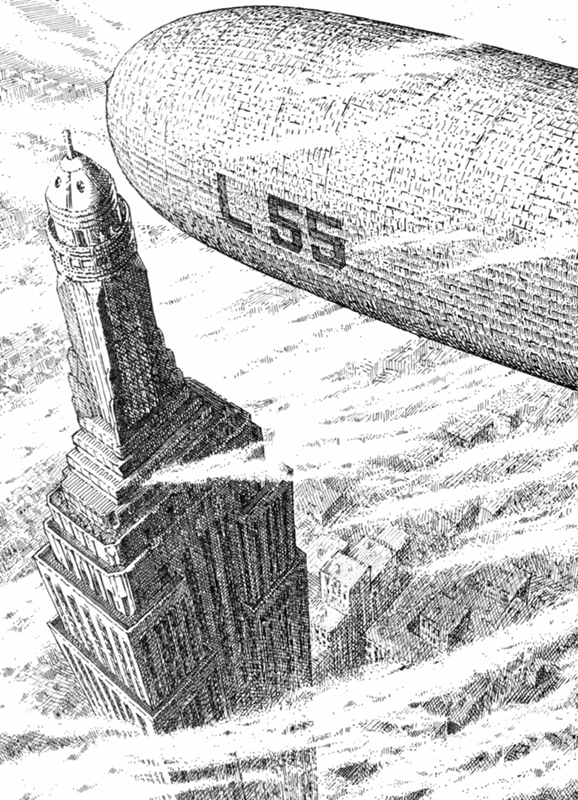
By the end of the 1920s the island of Manhattan was the undisputed skyscraper capital of the world. Since the turn of the century its buildings had been forced to grow upward because of both the high cost of land and the desire to build as much rentable floor space as possible on it. The construction of almost two hundred skyscrapers between 1902 and 1929 was made possible by improvements in the quality of steel, in the design of a structural-steel frame which could support both the floors and walls of these buildings, and in the capabilities of the all-important elevator. The erection of higher and higher buildings was encouraged both by increasing confidence in these technological advances and by a growing sense of competition among the buildings' owners.
It is not surprising that sometime in 1929 a few enterprising New York businessmen decided to build the tallest building in the world. What is surprising is that it was completely finished by the spring of 1931. The Empire State Building stood on the prestigious Fifth-Avenue site of the old Waldorf-Astoria Hotel. The one-thousand-and-fifty-foot-tall building contained eighty-five floors and sixty-seven elevators. On the roof was a two-hundred-foot mooring mast for dirigibles, which were thought at the time to be a potentially important form of transatlantic transportation. Although the mooring idea was quickly abandoned, the addition of the mast's seventeen stories ensured that the building was significantly taller than its closest rival, the seventy-seven-story Chrysler Building.
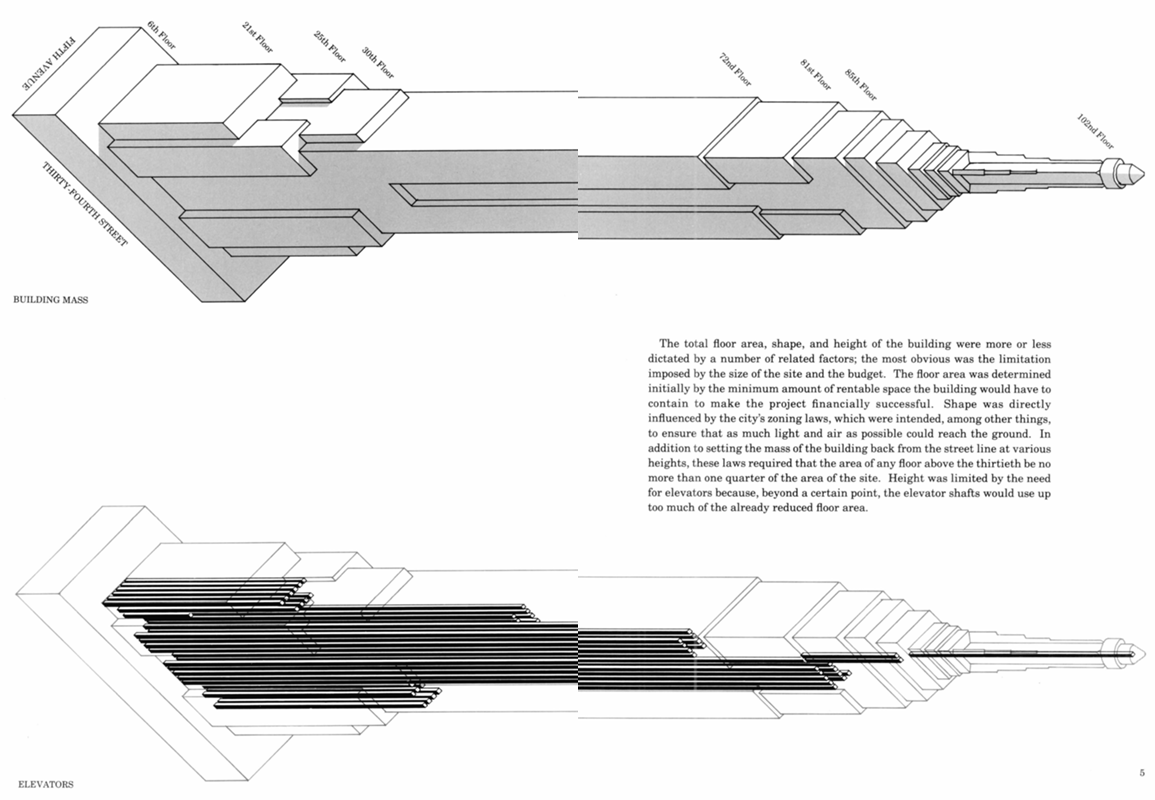

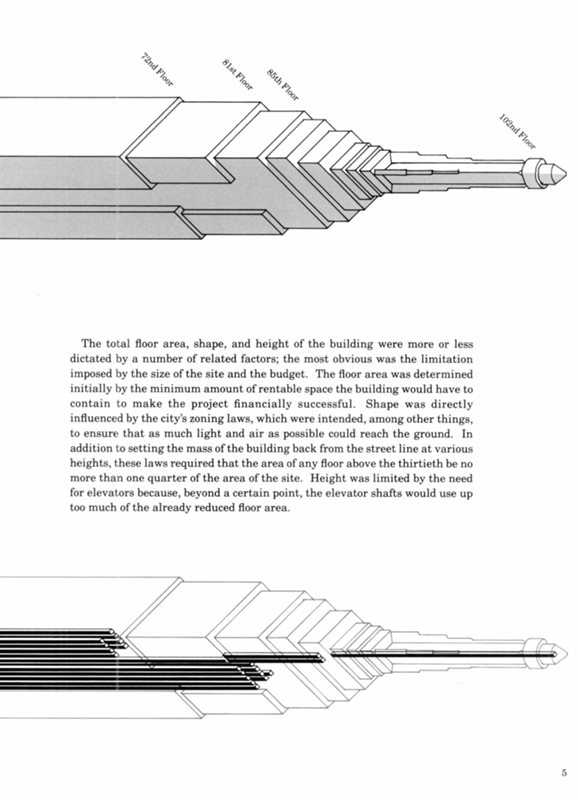
FIFTH AVENUE
6th Floor
21st Floor
25th Floor
30th Floor
72nd Floor
81st Floor
85th Floor
102nd Floor
THIRTY-FOURTH STREET
BUILDING MASS
ELEVATORS
The total floor area, shape, and height of the building were more or less dictated by a number of related factors; the most obvious was the limitation imposed by the size of the site and the budget. The floor area was determined initially by the minimum amount of rentable space the building would have to contain to make the project financially successful. Shape was directly influenced by the city's zoning laws, which were intended, among other things, to ensure that as much light and air as possible could reach the ground. In addition to setting the mass of the building back from the street line at various heights, these laws required that the area of any floor above the thirtieth be no more than one quarter of the area of the site. Height was limited by the need for elevators because, beyond a certain point, the elevator shafts would use up too much of the already reduced floor area.
The creation of the Empire State Building was a masterpiece of organization. The owners, architects, engineers, builders, and other key contractors worked together from the beginning. Not only did this unusual degree of cooperation eliminate needless delays during construction, but it also made it possible for the building to go up in less than eighteen months. At times the steel framework rose at a rate of four and a half stories a week.
On May 1, 1931, the building was officially opened. The day was filled with pomp, ceremony, and celebration. A luncheon party, held on the eighty-sixth floor, was attended by both the governor of New York State and the mayor of New York City. The lights of the main corridor were turned on from Washington, D.C., by the President of the United States. That evening another party was given on the eighty-second floor, from which the festivities were broadcast by radio to millions of listeners. The newspapers were filled with articles and editorials proclaiming this newest technological andin the face of the Great Depressionperhaps symbolic triumph.
It is highly unlikely that anyone caught up in the excitement of that particular May day in New York could have foreseen that the Empire State Building would be taken down in less than sixty years.
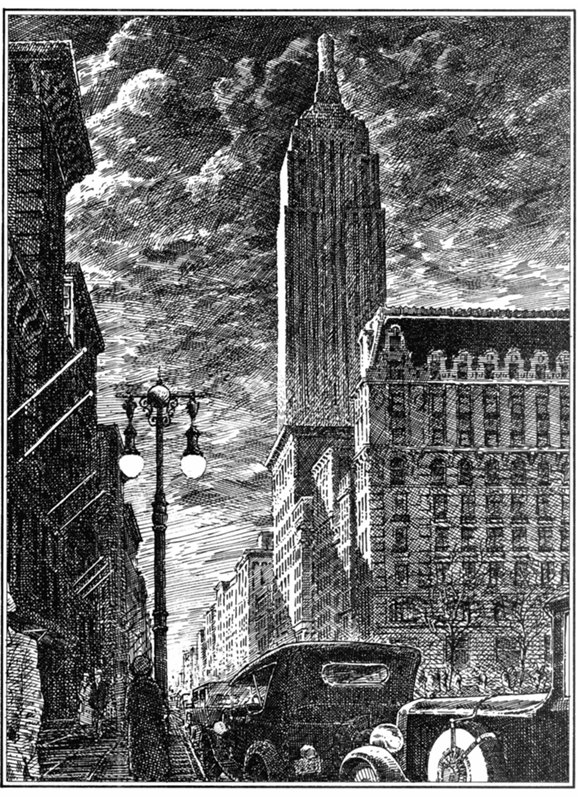
Copyright 1980 by David Macaulay
All rights reserved. For information about permission
to reproduce selections from this book, write to
Permissions, Houghton Mifflin Company, 215 Park Avenue
South, New York, New York 10003.
Printed in the United States of America
RNF ISBN 0-395-29457-6
PAP ISBN 0-395-45425-5
HC LBM PA CRW 20 19 18
HOUGHTON MIFFLIN COMPANY BOSTON DAVID MACAULAY
Library of Congress Cataloging in Publication Data
Macaulay, David.
Unbuilding.
SUMMARY: This fictional account of the dismantling
and removal of the Empire State Building describes the
structure of a skyscraper and explains how such an
edifice would be demolished.
1. WreckingJuvenile literature. 2. New York
(City). Empire State BuildingJuvenile literature.
[1. Wrecking. 2. New York (City). Empire State
Building. 3. Skyscrapers] I. Title.
TH153.M23 690'.523 80-15491
ISBN 0-395-29457-6
Special thanks to Julius Lipsett in New York
and to Ruth on the second floor.
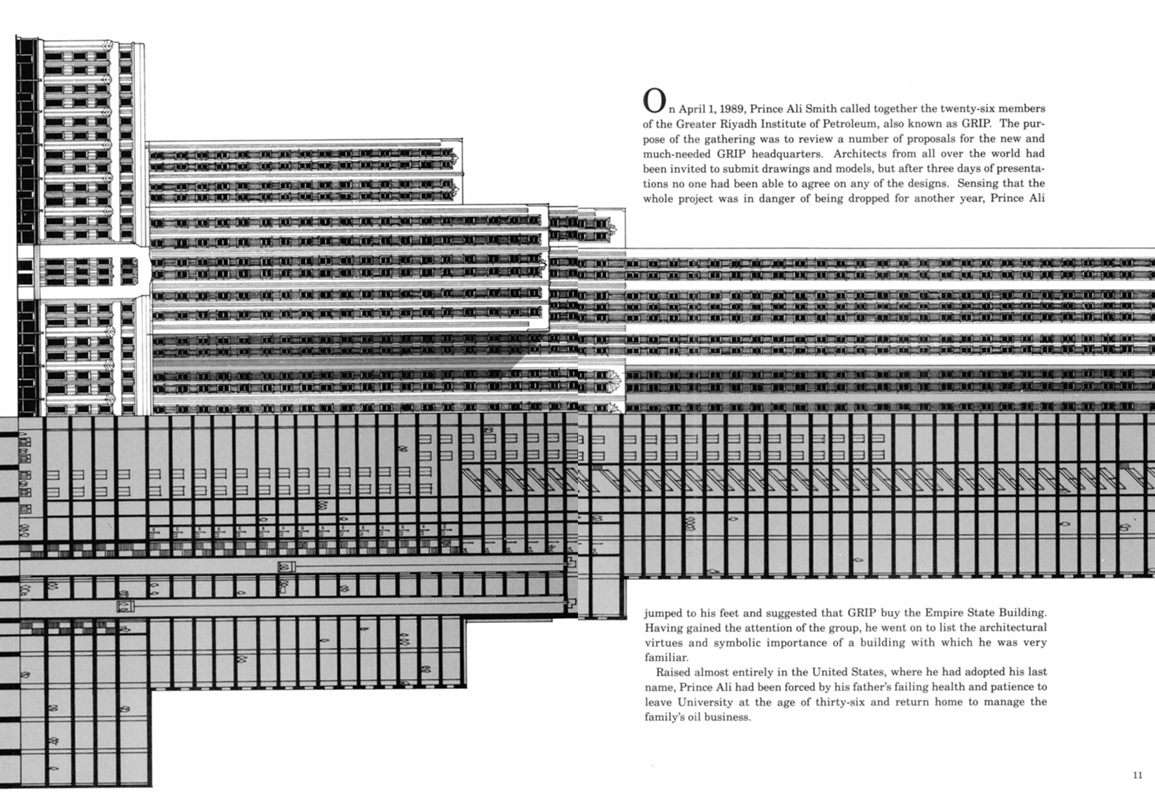
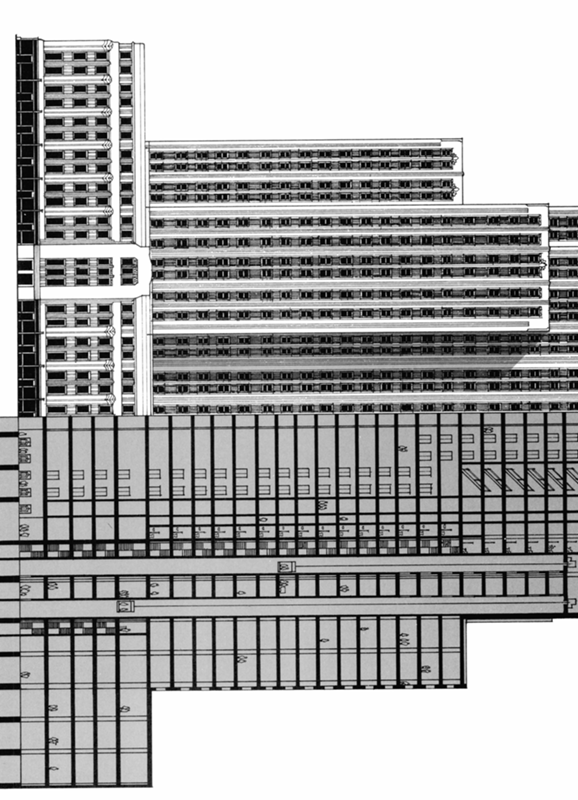
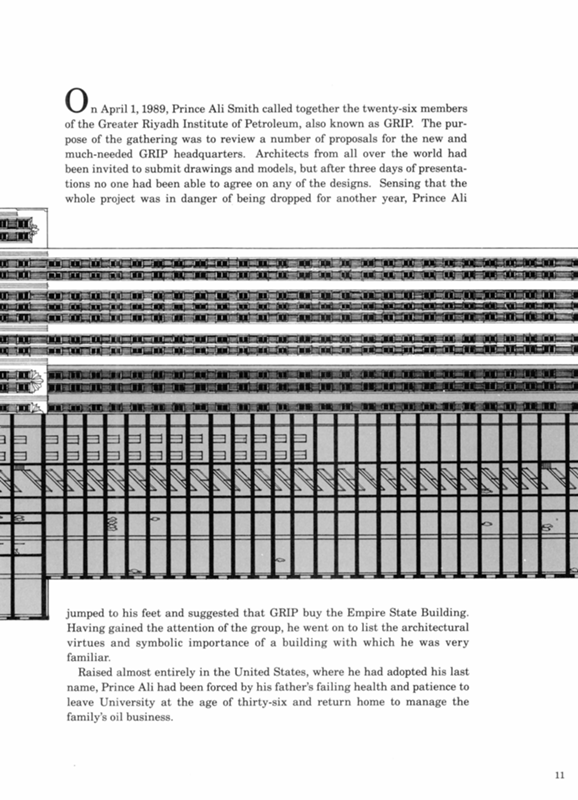
On April 1, 1989, Prince Ali Smith called together the twenty-six members of the Greater Riyadh Institute of Petroleum, also known as GRIP. The purpose of the gathering was to review a number of proposals for the new and much-needed GRIP headquarters. Architects from all over the world had been invited to submit drawings and models, but after three days of presentations no one had been able to agree on any of the designs. Sensing that the whole project was in danger of being dropped for another year, Prince Ali jumped to his feet and suggested that GRIP buy the Empire State Building. Having gained the attention of the group, he went on to list the architectural virtues and symbolic importance of a building with which he was very familiar.
Raised almost entirely in the United States, where he had adopted his last name, Prince Ali had been forced by his father's failing health and patience to leave University at the age of thirty-six and return home to manage the family's oil business.

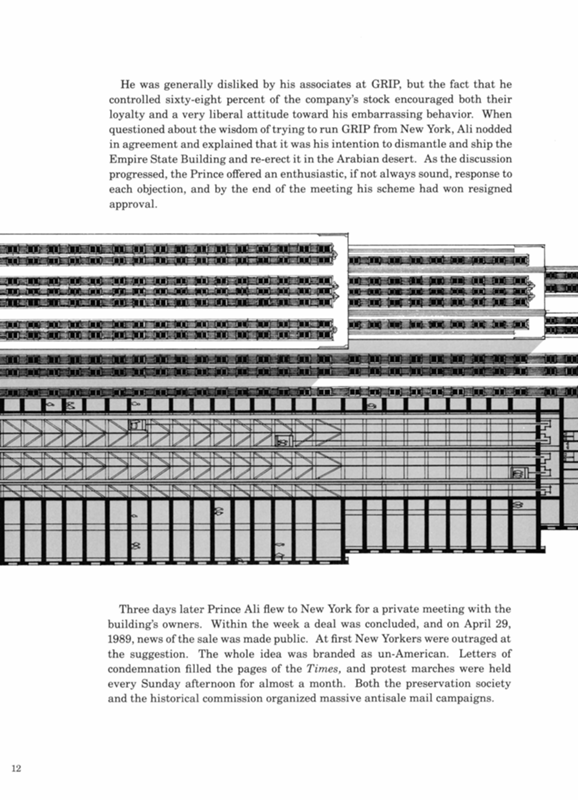
Next page









